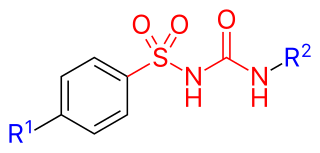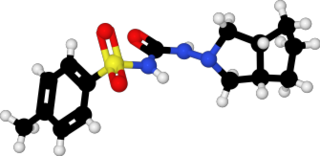
Glimepiride, is an anti-diabetic medication used to treat type 2 diabetes. It is less preferred than metformin. Use is recommended together with diet and exercise. It is taken by mouth. Glimepiride takes up to three hours for maximum effect and lasts for about a day.
Drugs used in diabetes treat diabetes mellitus by altering the glucose level in the blood. With the exceptions of insulin, most GLP receptor agonists, and pramlintide, all are administered orally and are thus also called oral hypoglycemic agents or oral antihyperglycemic agents. There are different classes of anti-diabetic drugs, and their selection depends on the nature of the diabetes, age and situation of the person, as well as other factors.

Sulfonylureas are a class of organic compounds used in medicine and agriculture, for example as antidiabetic drugs widely used in the management of diabetes mellitus type 2. They act by increasing insulin release from the beta cells in the pancreas. A number of sulfonylureas are also used as herbicides, because they can interfere with plant biosynthesis of certain amino acids. Sulfonylureas are also used experimentally to inhibit interleukin 1 beta release from the NALP3 inflammasome.
ATC code A10Drugs used in diabetes is a therapeutic subgroup of the Anatomical Therapeutic Chemical Classification System, a system of alphanumeric codes developed by the World Health Organization (WHO) for the classification of drugs and other medical products. Subgroup A10 is part of the anatomical group A Alimentary tract and metabolism.

Chlorpropamide is a drug in the sulfonylurea class used to treat diabetes mellitus type 2. It is a long-acting first-generation sulfonylurea.

Tolbutamide is a first-generation potassium channel blocker, sulfonylurea oral hypoglycemic medication. This drug may be used in the management of type 2 diabetes if diet alone is not effective. Tolbutamide stimulates the secretion of insulin by the pancreas.

Glibenclamide, also known as glyburide, is an antidiabetic medication used to treat type 2 diabetes. It is recommended that it be taken together with diet and exercise. It may be used with other antidiabetic medication. It is not recommended for use by itself in type 1 diabetes. It is taken by mouth.

Arecoline is a nicotinic acid-based mild parasympathomimetic stimulant alkaloid found in the areca nut, the fruit of the areca palm. It is an odourless oily liquid. It can bring a sense of enhanced alertness and energy, euphoria and relaxation. Its psychoactive effects are comparable to that of nicotine.

Gliclazide, sold under the brand name Diamicron among others, is a sulfonylurea type of anti-diabetic medication, used to treat type 2 diabetes. It is used when dietary changes, exercise, and weight loss are not enough. It is taken by mouth.

HLA class II histocompatibility antigen, DRB5 beta chain is a protein that in humans is encoded by the HLA-DRB5 gene.

ATP-binding cassette transporter sub-family C member 8 is a protein that in humans is encoded by the ABCC8 gene. ABCC8 orthologs have been identified in all mammals for which complete genome data are available.

Glyclopyramide is a sulfonylurea drug used in the treatment of diabetes. It has been marketed in Japan since 1965.

ZK-93426 (ethyl-5-isopropoxy-4-methyl-beta-carboline-3-carboxylate) is a drug from the beta-carboline family. It acts as a weak partial inverse agonist of benzodiazepine receptors, meaning that it causes the opposite effects to the benzodiazepine class of drugs and has anxiogenic properties, although unlike most benzodiazepine antagonists it is not a convulsant and actually has weak anticonvulsant effects. In human tests it produced alertness, restlessness and feelings of apprehension, and reversed the effect of the benzodiazepine lormetazepam. It was also shown to produce nootropic effects and increased release of acetylcholine.
Pirlindole is mainly a reversible inhibitor of monoamine oxidase A (RIMA) and secondly a SNRI which was developed and is used in Russia as an antidepressant. It is structurally and pharmacologically related to metralindole.

Glibornuride (INN) is an anti-diabetic drug from the group of sulfonylureas. It is manufactured by MEDA Pharma and sold in Switzerland under the brand name Glutril.
Neonatal diabetes mellitus (NDM) is a disease that affects an infant and their body's ability to produce or use insulin. NDM is a monogenic form of diabetes that occurs in the first 6 months of life. Infants do not produce enough insulin, leading to an increase in glucose accumulation. It is a rare disease, occurring in only one in 100,000 to 500,000 live births. NDM can be mistaken for the much more common type 1 diabetes, but type 1 diabetes usually occurs later than the first 6 months of life. There are two types of NDM: permanent neonatal diabetes mellitus (PNDM) is a lifelong condition. Transient neonatal diabetes mellitus (TNDM) is diabetes that disappears during the infant stage but may reappear later in life.
An orexigenic, or appetite stimulant, is a drug, hormone, or compound that increases appetite and may induce hyperphagia. This can be a medication or a naturally occurring neuropeptide hormone, such as ghrelin, orexin or neuropeptide Y, which increases hunger and therefore enhances food consumption. Usually appetite enhancement is considered an undesirable side effect of certain drugs as it leads to unwanted weight gain, but sometimes it can be beneficial and a drug may be prescribed solely for this purpose, especially when the patient is suffering from severe appetite loss or muscle wasting due to cystic fibrosis, anorexia, old age, cancer or AIDS. There are several widely used drugs which can cause a boost in appetite, including tricyclic antidepressants (TCAs), tetracyclic antidepressants, natural or synthetic cannabinoids, first-generation antihistamines, most antipsychotics and many steroid hormones. In the United States, no hormone or drug has currently been approved by the FDA specifically as an orexigenic, with the exception of Dronabinol, which received approval for HIV/AIDS-induced anorexia only.

Glicaramide (SQ-65993) is an orally bioavailable anti-diabetic medication. It has a similar potency as glibenclamide (glyburide) in the class of medication known as sulfonylureas. Its structure is similar since it has a cyclic acyl group which replaces the latter's 2-methoxy-5-chlorobenzyl. Same as glibenclamide, it is classified as a second-generation sulfonylurea. It may have more pronounced extra-pancreatic effects than glibenclamide or tolbutamide.
Glibenclamide/metformin, also known as glyburide/metformin and sold under the brand name Glucovance, is a fixed-dose combination anti-diabetic medication used to treat type 2 diabetes. It contains glibenclamide, a sulfonylureas, and metformin, a biguanide.















